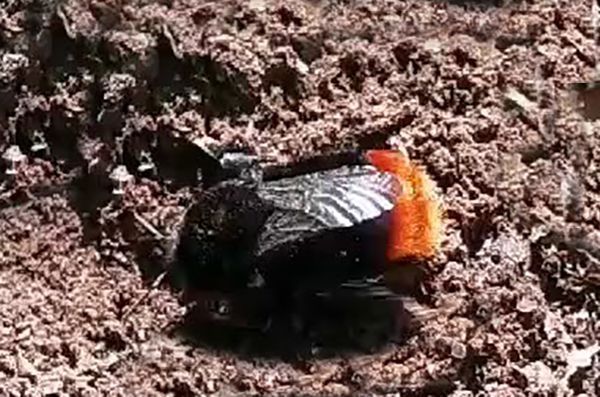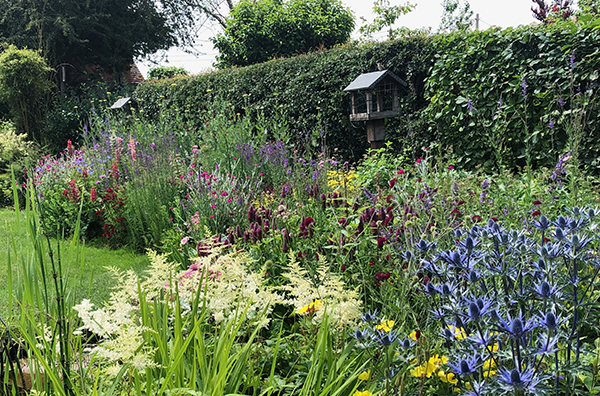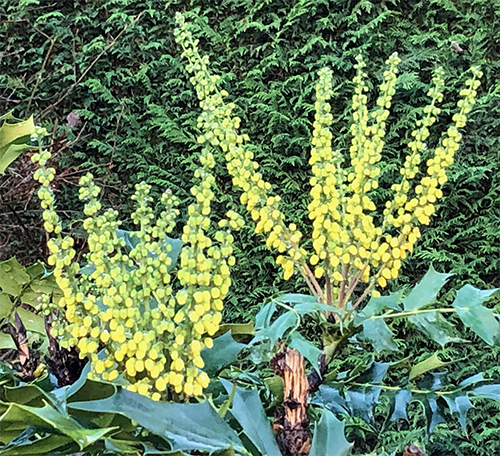This week, in a rare rain-free 15 minutes in the garden, I unearthed a couple of red-tailed bumblebees (Bombus lapidarius) from an old wooden trough that had gone rotten. They appeared to have been completely submerged in the soil among the roots of a woody lavender, and they were not at all happy about being disturbed.

There was a lot of frantic buzzing and stumbling around as they shook off the soil and tried to get their bearings from what, presumably, had been the start of a long, sleepy hibernation. It got me thinking…where do all the bumblebees go at this time of year?
Bumblebee life cycle
A quick session with Mr Google brought me up to speed on the life cycle of bumblebees, which starts with the emergence of a queen bee in spring. She establishes a nest and lays about a dozen eggs that hatch into sterile female worker bees. Some of the workers guard or clean the nest, while others forage for pollen and nectar to feed further broods of workers through late spring and early summer.
I’ve made a concerted effort in recent years to only introduce pollinator-friendly plants to the garden, so during the summer my borders are buzzing with worker bees.

In late summer, the queen starts to produce fertile females (next year’s queen bees) and males, which leave the nest. The males mate with new queens from other nests. They die before the start of winter, as do the worker bees and original queen bee.
The newly mated queens then find a cool, quiet place to hibernate, where they will use reserves of energy stored as fat in the body to see them through the winter. Typically, they burrow into soft soil in North-facing banks, or find shelter under logs or stones, to avoid being warmed up by the winter sun.
Winter-flying bumblebees
Any increase in temperature could bring the queens out of hibernation. With our seasons getting more confused (I’ve already spotted some daffodils emerging!) and our winters getting warmer, we are likely to see more and more queen bees out and about during the winter months. In fact, in milder southern counties of the UK, some queen bumblebees, particularly the buff-tailed species (Bombus terrestris), don’t hibernate at all. Instead, they choose to start a new nest early, particularly in areas where there is a rich supply of pollen and nectar from winter-flowering plants.

I often see bees on my Mahonia in December and January. It’s a wonderful winter-flowering plant that blooms through several of the coldest months. Other good sources of bee food during the winter include winter-flowering heathers, evergreen clematis (Clematis cirrhosa) and the winter honeysuckle (Lonicera fragrantissima).
What to do if you find a hibernating bumblebee
If you unearth a hibernating queen bee by mistake and she isn’t very active, the Bumblebee Conservation Trust recommends covering her up again (loosely, so that she can get out!). Otherwise, place her in a sheltered place so that she can rest before finding a new hibernation site.
As for my two angry bees, I couldn’t return them to their original site (as I had demolished it), and they were way too active anyway, so I gently transferred them onto a late-flowering scabious where they could feed and rest before finding a new spot in which to see out the winter.

Bee happy
Although I’m sure to see one or two bumblebees over the next few months, I will miss the sound of buzzing in the garden and look forward to the return of the workers in spring. Until then, I will have to make do with my new doormat, which makes me smile every time I come into the house. Trouble is, it’s way too pretty to wipe my feet on it!

